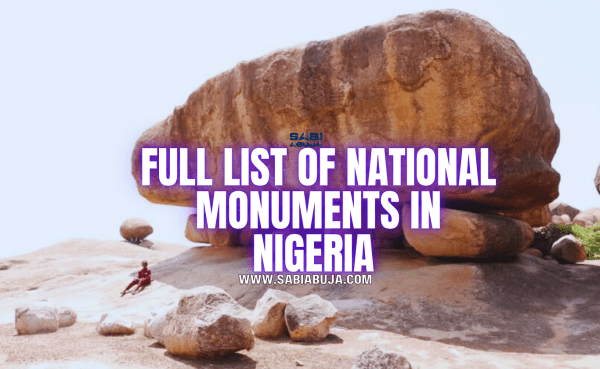
Nigeria is a country teeming with history, culture, and ancestral legacy. From ancient palaces to prehistoric rock paintings, sacred groves to colonial forts, Nigeria’s national monuments reflect its deep-rooted heritage and complex past. Recognized by the National Commission for Museums and Monuments (NCMM), these sites have been preserved for their historical, artistic, and cultural value.
If you’re a cultural explorer, historian, student, or a tourist curious about Nigeria’s identity, here is a comprehensive list of national monuments in Nigeria.
National Monuments in Nigeria
Abia State
-
Chief Okoroji’s House, Arochukwu
-
Obu House, Elu Ohafia
-
Chief Ochu Kalu’s House, Ndi Okereke Abam
-
Omo Ukwu of Ndi Nzera Clan, Asaga-Ohafia
Adamawa State
-
Sukur Cultural Landscape, Madagali (UNESCO World Heritage Site)
Bauchi State
-
Gidan Madaki, Kafin Madaki
-
Dutsen Damisa Rock Painting, Near Gumje
-
Dutsen Zane Geji Rock Paintings, Toro
-
Shadawanka Rock Paintings
-
Shira Rock Paintings, Shira
-
Cairn of Stones at Panshanu Pass (Kwandonkaya), Near Mile 31 on Jos-Bauchi Road
-
First Mining Beacon, Tilden Fulani
Borno State
-
Rabeh’s House/Fort, Dikwa
Cross River State
-
The Old Residency, Calabar
-
The Old Consulate, Calabar
-
Chief Egbo Bassey’s House, Calabar
-
Carved Stone Monoliths at Alok
-
Carved Stone Monoliths at Emaghabe
Delta State
-
Palace of Chief Nanna of Koko
Edo State
-
Chief Ogiamen’s House, Benin City
-
Chief Aikoriogie’s House (Enogie of Obazagbon)
-
Benin City Walls and Moat
Enugu State
-
Chief Nwokolo’s House, Ukehe
Jigawa State
-
Rock Paintings at Dutsen Habude, Birnin Kudu
-
Rock Paintings at Dutsen Murufu, Birnin Kudu
-
Rock Inscriptions at Dutsen Mesa, Birnin Kudu
-
Rock Paintings at Dutsen Zango, Birnin Kudu
Kaduna State
-
Zaria City Walls
-
Kufena Hills, Near Zaria
-
Steel Foot Bridge Built by Lord Lugard
-
Habe Mosque, Maigana
Kano State
-
Habe Mosque, Bebeji
-
Gidan Makama
-
Kano City Walls and Gate
Katsina State
-
Gobirau Minaret
-
Tumuli and Baobab Tree (Durbi-Takusheyi)
-
Old Katsina Training College
Kogi State
-
Ojogwu Atogwu Tumulus near the Palace of the Attah of Idah
Kwara State
-
Relics of the Steamer “Dayspring”, Jebba Station
-
Old WAFF Fort, Okuta
-
Old WAFF Fort, Yashikera
-
Stone Figures at Ofaro
-
Stone Figures at Ijara
Lagos State
-
Ilojo Bar, Lagos Island
-
Iga Idunganran (Oba’s Palace), Lagos Island
-
Water House, Lagos Island
-
Old Secretariat, Marina
Niger State
-
Tsoede’s Tomb, Gwagwade
-
Site of Mai Jimina’s House, Wushishi
-
Ruins of Colonial Government House, Zungeru
-
Katamba of the Palace of Etsu Nupe, Bida
Ogun State
-
Sungbo’s Shrine, Oke-Eri, Near Ijebu-Ode
Ondo State
-
Igbara Oke Petroglyphs, near Igbara Oke
-
Iwo Eleru Cave, Near Owo
-
Old Palace of the Deji of Akure
Osun State
-
Osun Grove and River-side Shrine, Osogbo (UNESCO World Heritage Site)
-
Shrine of Osun, King’s Market, Osogbo
-
Shrine of Osun at Afin Ata-Oja (Palace), Osogbo
-
Ita Yemoo, Ile-Ife
-
Carved Stone Figure at Igbajo
Plateau State
-
Stone Causeway at Batura, Bokkos
-
Stone Causeway at Forof, Bokkos
-
Stone Causeway at Tading, Bokkos
Rivers State
-
King Jaja’s Statue, Opobo
Sokoto State
-
Ruins of the Ancient City of Surame (UNESCO Tentative Site)
Frequently Asked Questions About National Monuments in Nigeria
1. What are national monuments in Nigeria?
National monuments in Nigeria are sites, structures, or locations officially recognized and preserved by the National Commission for Museums and Monuments (NCMM) due to their historical, cultural, architectural, or archaeological importance.
2. Who manages Nigeria’s national monuments?
The National Commission for Museums and Monuments (NCMM) is the federal agency responsible for managing, preserving, and protecting Nigeria’s national monuments.
3. How many national monuments are there in Nigeria?
There are over 60 officially recognized national monuments spread across different states in Nigeria. These include palaces, colonial buildings, rock art sites, ancient city ruins, and religious shrines.
4. What are some of the most popular national monuments in Nigeria?
Some of the most notable ones include:
-
Benin City Walls and Moat (Edo State)
-
Kano City Walls and Gates (Kano State)
-
Sukur Cultural Landscape (Adamawa State – UNESCO World Heritage Site)
-
Osun-Osogbo Sacred Grove (Osun State – UNESCO World Heritage Site)
-
Chief Nanna’s Palace (Delta State)
-
Iga Idunganran (Oba’s Palace) (Lagos State)
5. Are national monuments in Nigeria open to the public?
Yes, many national monuments are open to the public for tours, educational visits, and research. However, access may require permission or entrance fees in some cases.
Final Thoughts
These monuments are not just structures, they are stories in stone, wood, and earth. They offer insight into Nigeria’s evolution from prehistory through colonialism to modern times.

Leave a Reply